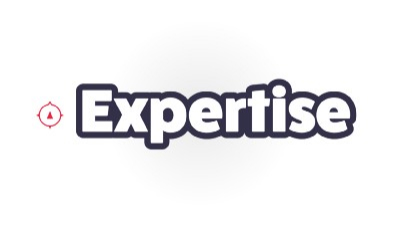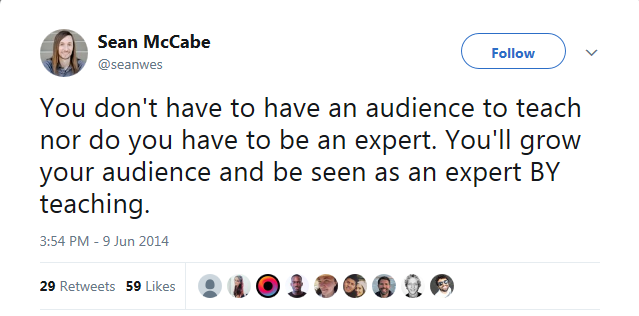My personal goal as a designer is to become a master of my craft. I’m a brand identity designer who focuses on mapping business goals to design strategy. I help businesses reach their goals with their communication and products to craft the visual approach to their brand.
I want to become one of the go-to resources for what I do.However, relative to the big race of life, I just started my journey.
This requires that I actively work towards becoming an expert in my field, and that takes deliberate practice.
Our topic is to go over how to build the expertise that employers and clients look for when hiring a new designer.
Not everyone will have the same goals as I do and I respect that. But if your goal is even just getting to the next level of what you do, then let’s chat (:
Most people don’t feel like they are an expert or are even becoming an expert
We all have times where we struggle with accepting how skilled we actually are at our craft. When I talked a few months ago about bridging the gap between where you are and where you want to be, I started to notice something. Impostor syndrome affects Everyoneat any level.
I had recently reached out to the members of the Compass of Design community about this topic, asking them:
What do you feel like you’re an expert at with design? If you don’t feel like an expert what do you want to be an expert in as a designer?
What I started to see is that not everyone feels that they are becoming expertsat what they do. But the majority of them understand that learning quickly and learning how to learn are keys to being successful in their field.
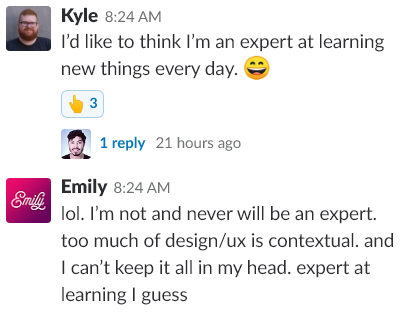
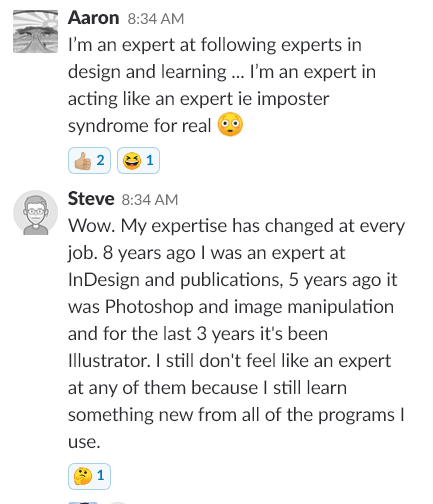
Kyle also pointed out that someone with the self-procalimed title of “expert” almost never works out. I definitely agreed with that. The title of expert is earned through the eyes of others.
Though these friends of mine above may not feel like experts, they have specific skills that I see in them that I would hire them specifically for the type of design work they have shared.
This is one of my plans with the members of the community as I run my own design agency. I keep tabs on what these friends of mine are good at so I can hire them in the future should I need to.
It’s really important that you become a go-to resource for the type of work that you do.
Not everyone will become an expert. Not everyone has to.
If everyone were an expert at what they do, then we wouldn’t have experts, we would only have a new bar set for the level of work we do.
Building expertise in your field of work takes time and deliberate effort, but if your goal is to make a living doing what you do vs. doing it as a hobby, you will be consciously working to get better anyways.
Malcolm Gladwell, a reasonably known journalist, had worked to answer why a person’s environment, in conjunction with personal drive and motivation, affects his or her possibility and opportunity for success.
Basically, why are people who become a professional, an expert, a master… why do they all have similar stories?
He touched on the 10,000-hour rule to master a skill, stating that a person who deliberately practices what they are working on can expect to spend 10,000 hours working towards mastery in any craft.
As the reference, a typical work-week in America is spending 40hrs at a job that you do, equating to around 2,000 hours in a yearspent working as a full-time employee.
You would expect that after five years that a person would automatically reach the status of an “expert,” but this rarely happens. Sure you can become good at what you do, but without deliberate practice at improvement, you can expect to peak outat a certain point.
The keywords that you need to focus on here are “Deliberate” and “Practice.”
You’ve got to learn the intricate, challenging, and real processes of the work you do.
There are three things to focus on when building your expertise.
Focus on Doing the work
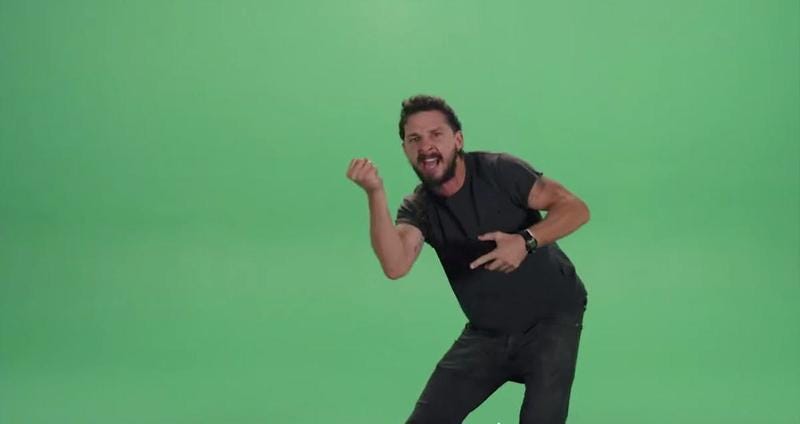
By actually doing the work that you set out to be doing, you’re getting a head start on the type of people who need to have all their ducks in a row to start something.
Start making things, even when you’re sure the work will look like crap. The fun part is that you’ll start to get better over time.
Practice enough to say that you can do that thing at a basic level, andstart replacing your “practice projects” with actual client work.
Build a body of work, specifically around what you want to build expertise in.
I’ve seen some good examples where the body of work speaks for itself. Whether someone’s work is filled solely with practice projects or live projects for jobs, they were hired to do, having a lot of work around what you want to be known for is usually a good example that you know what you’re doing in that field.
As a brand identity designer, I’ve cut out most of the work that I did in the past for web design and UI design from my portfolio. My work that is online is the type of work that I want to be hired to do. That then I continue building the list of work that I’ve done and cut out work that I don’t want to be doing.
I don’t want people to look at what I do and be unclear what I can actually do for them. You have to work on something that you’re best equipped to do. Which if you’ve been following along with finding your niche, you’re probably in tune with what skill you want to drive forward with.
It was scary for me to abandon a portfolio that I had worked so hard to build, but in the end it was the best decision.
Showcase this work
The most effective thing you can do to show your expertise through work that you have completed is to write case studies.
The case studies can be simple reflections on what you did and learned as a result, or you can craft this to what a person would need to know about your work process and the results of the work you do to hire you.
But if you only post pictures of your work without writing about how that was effective, then you mostly are just creating an art gallery which is a collection of pretty pictures.
Make the work that you completed work for you. Put your portfolio to work by crafting case studies to back the results of your projects.
Focus on learning
A day that you learned something new is never a day wasted.
But remember that learning all day does you nothing if you don’t implement what you’re learning in the real world.
Actively practice what you’re learning. So focus again on the Doing.
This is one of the fastest ways to build your skills as a designer.
Learn something, do it, post results.
Or, more specifically:
Learn something, implement it into what you’re doing, post what the finished result is… and then try to teach it to somebody who’s trying to learn it.
We constantly share resources that we find within the community and we focus on sharing things we think specific people would benefit from. Collectively we’re building a huge library just for the various design disciplines within the group.
Focus on Teaching
I know a lot of people groan about “putting out content”and how everyone does it and it is overrated.
There’s also a bit of stigma behind the notion that “Those who can, do it. Those who can’t, teach it.”
People have this historical view of teachers that came from traditional schooling. You had to go to school for a long time to become a teacher. To attain the teacher status, it meant that there wasn’t a lot of real-world experience behind that teacher. There are some who accomplished it, but the stigma behind this idea stuck.
The reason why I teach is that I am getting that real-world experience as I go, and someone who’s just a step or two behind me could use the relevancy of the lessons I have learned to help themselves.
Juliane and I in the community are working towards similar goals with similar design disciplines. So everything that I go through ends up helping her in her situations as well. Especially on the topic of showcasing our expertise in our work and working with clients.
To me, the most important reason that I do teach is that I learn faster by teaching what I know.
To teach someone means you need to audit what you think you knowand evaluate if it’s honestly the right way to do things.
You may think you know how to do something, but until you try to explain that concept to other people, what you know is just a reactionary instinct rather than a skill.
What you get from me each week is me answering people’s questions or situations by sharing everything that I know.
To quote Sean from seanwes: You start to be seen as an expert in what you do because you teach.
When I started my newsletter, it took months for me to break past 20 subscribers. As my skills with writing continued to improve, so did the level of value in what I was teaching improved.
There are people still commenting and receiving value in my early writing (as bad as it is to read) because it meets them where they are at with what they are dealing with at that moment.
You will win the game of content by relevancy over the recency of your teaching.
How does this help you? It gives you social proof that you know a lot about what you’re doing.
Getting social proof.
On top of getting the body of work, including the case studies, starting to teach, your work will be further fueled by evidence that you can teach what you know.
Clients and employers might not get a lot out of the things you are sharing about your work, but that doesn’t mean that they won’t recognize a lot of posts, videos, tutorials, infographics, etc. that show you exercising the skills you’re learning.
If your content resonates as well, sharing the number of comments, shares, likes, favorites, shout-outs, events that you’ve spoken at… all of this will help give evidence that what you know is quality value and not just acting like you know something.
Get testimonials
Another form of social proof is testimonials on your work, your process, and your results. This can come from employers, peers, past clients, all of which help strengthen the trust in others that you know what you’re doing.
There is something to be said about having substantial evidence from someone who isn’t you, talking about the work you do from another perspective. It humanizes the content that’s on your site, and psychologically is a little more trustworthy than if you had said it.
Imagine Amazon.com without all the reviews…
After having a conversation with Sean McCabe, he recommends that I have a few things with the testimonials on my sites:
that they stand out from other content on your site
that they reference your work
that you use the testimonial near a place where you want someone to take action
that you get permission to use their profile photo and a link back to them (people will verify this… as evidenced by the number of clicks I have on my testimonial’s names on my sites). You can also check Gravatar to see if there’s a public profile photo for their email address
Get real numbers or data that showcase how your brand helped their brand achieve their goals.
When we talked about Jobs to Be Done a little while ago, it raised an idea with me about keeping tabs on the progress one makes from the work you’ve done.
There’s a company I follow (and pull ideas for case studies from) that showcase the results of the work they did. These, along with a full case study, testimonials on the job, and visual examples of what was completed is the pinnacle of how you should be showcasing the expertise behind what you’ve done.
Jordan Aspen, an acquaintance of mine, reminds me that you shouldn’t wait for results to post your case studies. But do publish the case study first, and then any data and testimonies later that you can get are icing to this ideal presentation of work.
So if you’ve been wondering what ways we should be showcasing our expertise on our sites for our products and services let’s recap.
This is everything that I’m working on doing right now:
Keep learning something every day
Start actually implementing the things you’re working on in your process
Share your work through case studies that include results and testimonials (at the very least, still just use a case study)
Build a body of work that continues to improve from what you learn each day
Start finding ways to teach what you know
Build up a backlog of what you’ve done to teach
Showcase social proof through testimonials from other people who have given feedback on their projects you’ve done
I hope this has resonated with everything that I’m practicing here. This may be a lot of things to implement and it does take time!
For those of us who are in the community, I’m working with a few people on helping get their portfolios up to speed. If that’s something you want, hit me up in the community and we will work on this together to start improving how you showcase what you’re good at and get that portfolio working for you. (:
Thanks, catch you all next week!

Take another step towards learning more about design from other designers.
Come join other like-minded designers who are working at becoming masters of their craft.
Every week we go over ways to market yourself better by improving your design skills, your personal brand, and other topics to further develop as a great designer.
Our community registration opens up once a quarter, so get on the newsletter to stay updated!


